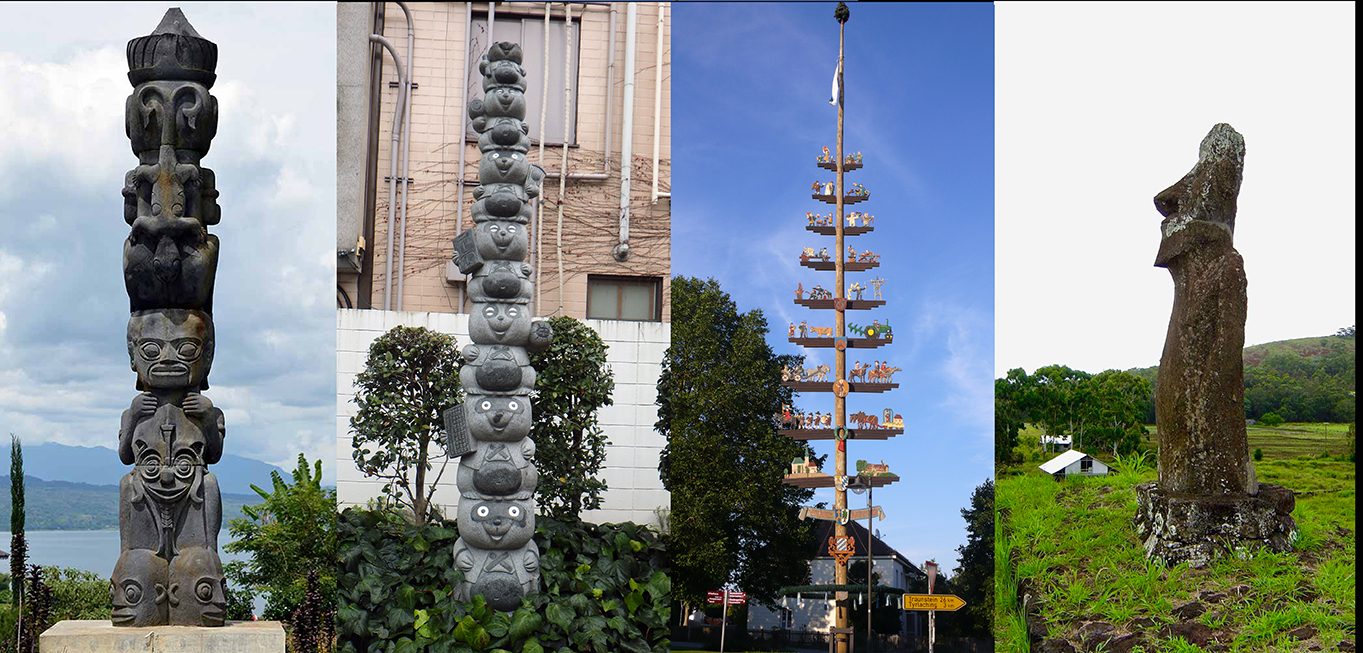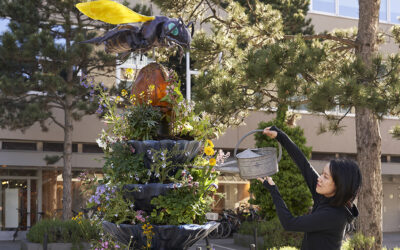Exploring Totemism: Ancient Practices and Modern Art
As an integral part of his PhDArts journey, Hans Kalliwoda embarked upon an exploration of totemism, an ancient pagan practice renowned for its ability to foster strong communal bonds. Over the course of the past tens of millennia, totemic traditions have undergone diverse and dynamic transformations across different cultures worldwide. These transformations have given rise to a rich tapestry of variations in both the visual and performative dimensions of totemism, with the latter encompassing various ritualistic aspects. Despite the remarkable diversity in these expressions, a common thread runs through them all: the capacity to engender social cohesion.
Totemism as innovative method in the framework of social sculptures
Kalliwoda’s artistic endeavours have led him to the development of innovative methodologies within the framework of a social and dynamic sculpture. These sculptures transcend conventional notions of a mere ‘street object,’ and burst the conventional framework of ‘art in public space’ as it actively involves local residents, transforming them into proprietors and custodians of this art form. This unconventional approach to art holds the distinctive characteristic of being intercultural, welcoming individuals regardless of their faith, cultural heritage, or age group. Furthermore, it maintains a low threshold of accessibility, ensuring that it can be readily embraced by a wide and diverse audience, thereby promoting unity and inclusivity.
Totemism symbolises social entities using natural symbols
Totemism is a concept rooted in the systematic symbolisation of social entities, like individuals and social units, using concrete natural symbols, often species, which are then developed into relationships encompassing identity, power, and common origin. The term “totem” originated from “dotem,” used by the Ojibwa people to refer to clan membership.
Reimagining Totemism’s Origins
Kalliwoda has set out to reinterpret and adapt the concept of totemism that has always fascinated him. He argues that the exact origins of totemism is uncertain and may date back to a time when cave paintings were made. However, these origins are likely to be in a pre-religious era when human societies are referred to as ‘pagan’. During this time, the spirituality and belief systems of these pagan societies were highly influenced by natural phenomena, and there was a strong sense of connection with nature. Remarkably, traces of this view have been preserved in this context among the various ethnic groups up to the present day.
Connection between man and nature
In contrast, ‘modern’ organised religions have often propagated the idea that humans stand apart from, and even above, the natural world. These ideas and approach, that is part of the hyper-individuality has been carried over to this day. While many Enlightenment ideas reinforced anthropocentrism (human-centered thinking), there were also critiques of this perspective. Some thinkers questioned the assumption that nature existed solely for human benefit. Philosopher Jean-Jacques Rousseau, who highlighted the importance of responsible stewardship of the environment, ethically arguing for a more harmonious relationship between humans and nature.
Function and Interpretation of Totemism
When examining the historical perspectives on this phenomenon at a scholarly level, one encounters a spectrum of interpretations, concepts, and hypotheses. For instance Frazer’s work on totemism emphasised the function of solidarity, bringing people together into social groups. He suggested that totemic species acted as repositories of the soul. Later, he proposed the economic basis of totemism based on the Intichiuma rites of central desert Aborigines. Freud incorporated totemism into his psychodynamic analysis of cultural and religious forms, linking it to oedipal guilt and the murder of the primal father. Arnold van Gennep and later Claude Lévi-Strauss continued the debate. Lévi-Strauss, in particular, critiqued the concept of totemism, reducing it to a mere system of classification without a substantive analogic relationship between totem and social unit.
Totemism in Practice
In practice, totemism involves symbolising social units through natural species. It can range from universalised systems encompassing all aspects of experience to specific attributions of traits or qualities to individuals based on their totemic affiliations. Totemic symbolisation is frequently included in more comprehensive cosmological systems and has the ability to confer meanings and identities to social groups that go beyond simply labelling them. For example, in some indigenous cultures, a particular animal may be seen as a totemic symbol of a particular tribe or community. This goes beyond just being a symbol, as it reflects the beliefs and values of the community and gives them a sense of identity and connection to the natural world.
Parallels to the Bavarian and Austrian Maibaum (Maypole): Cultural Symbols and Community
A ‘Maibaum’ in southern Germany, also known as a Maypole in English relates to totemism by sharing some thematic elements, particularly in its use of symbols, community bonding, and connection to nature. It’s a cultural practice that reflects the values and identity of the community that erects it, much like totemism reflects the values and identity of the groups that practice it. In almost all communities there are still guilds today, which often maintain certain customs and traditions and thus preserve the importance of the crafts in the community. Maypoles with guild symbols can thus also serve as a symbol for the passing on and preservation of these traditions. It is important to emphasise that the symbols on a maypole are very individual and often depend on the history and traditions of the respective region or community.
Overall, totemism, often associated with ‘primitive thought,’ is a complex cultural phenomenon that involves the intricate interplay between concrete imagery and abstract reference, with diverse societies choosing either symbolic differentiation through natural species or other means depending on their social structures. This choice is not a matter of primitiveness but a reflection of the complementarity between social form and symbolic alternatives.
Image: Examples of totems placed in public spaces and originating from different cultural backgrounds.


